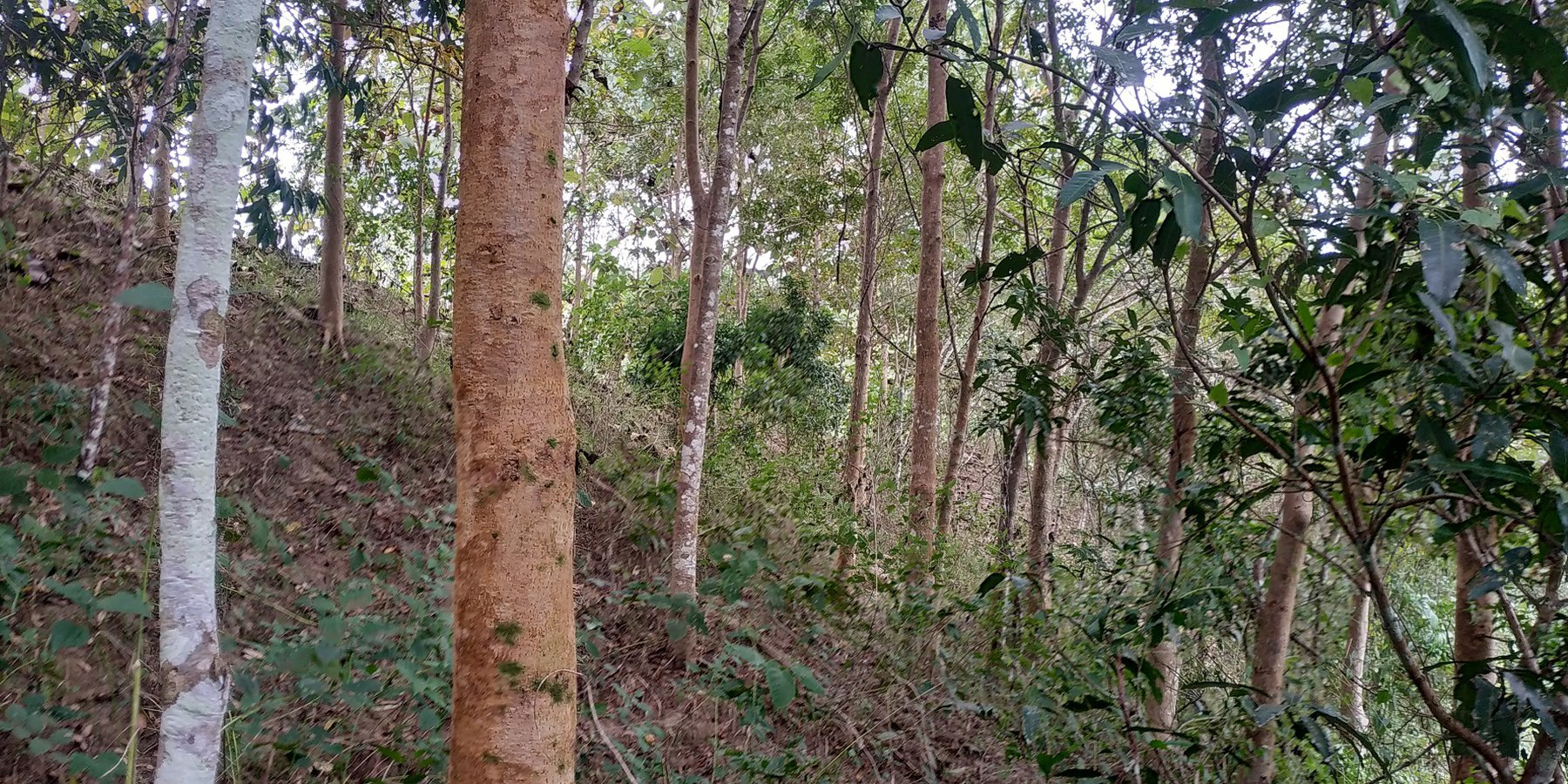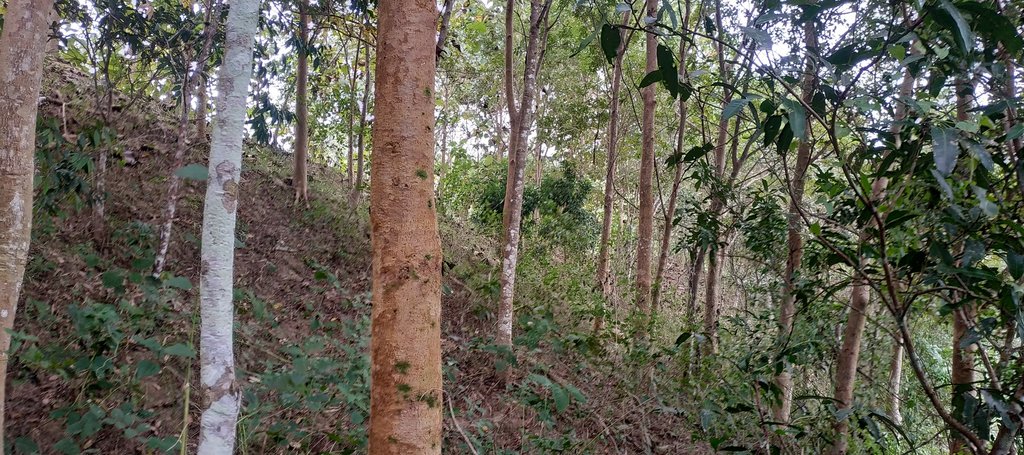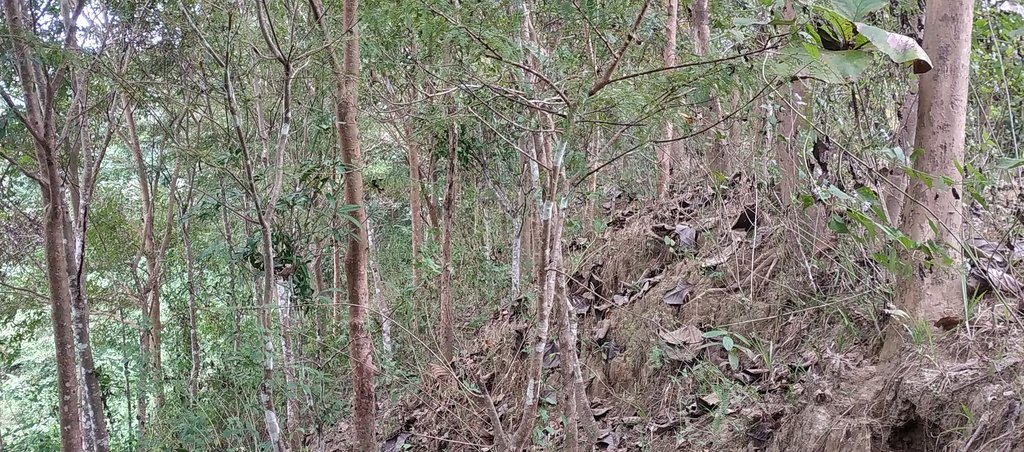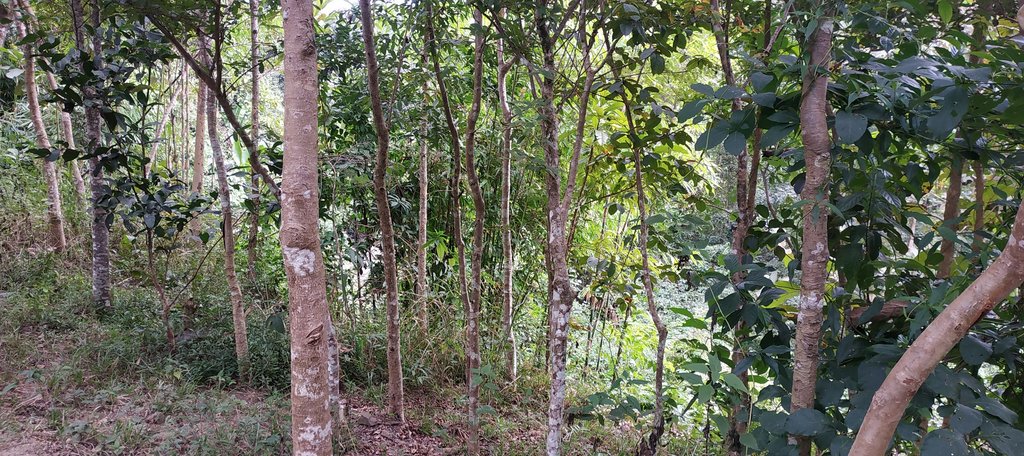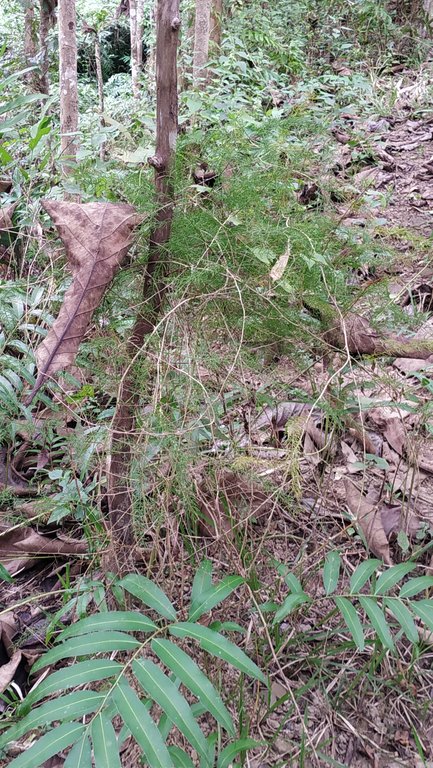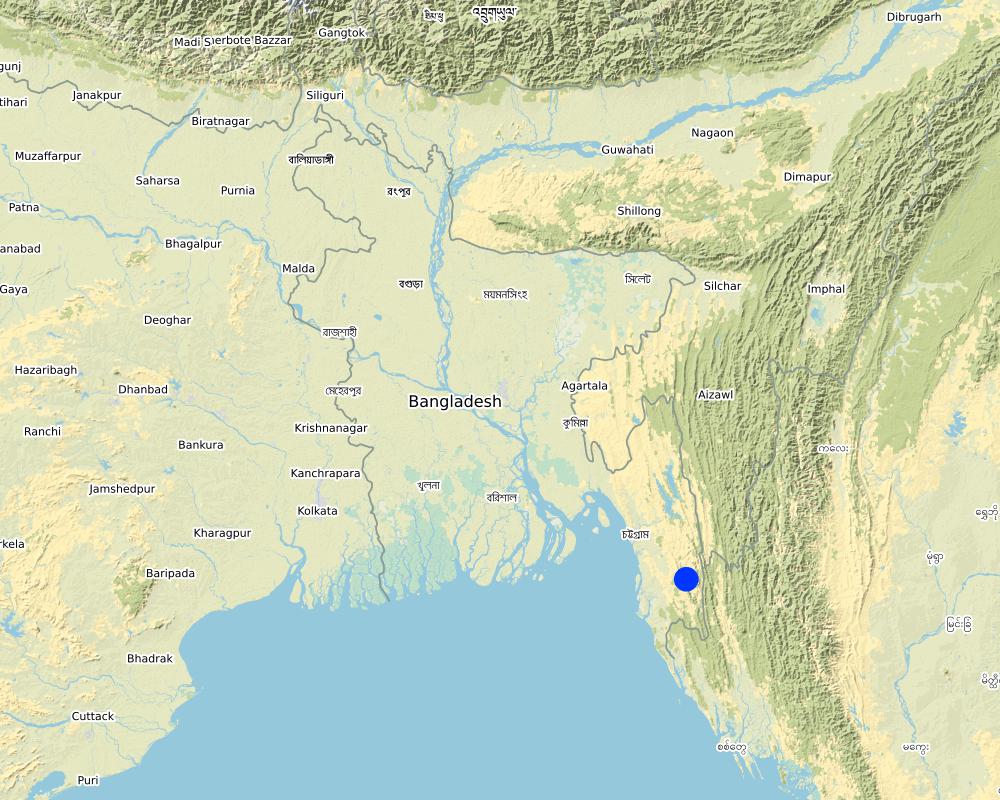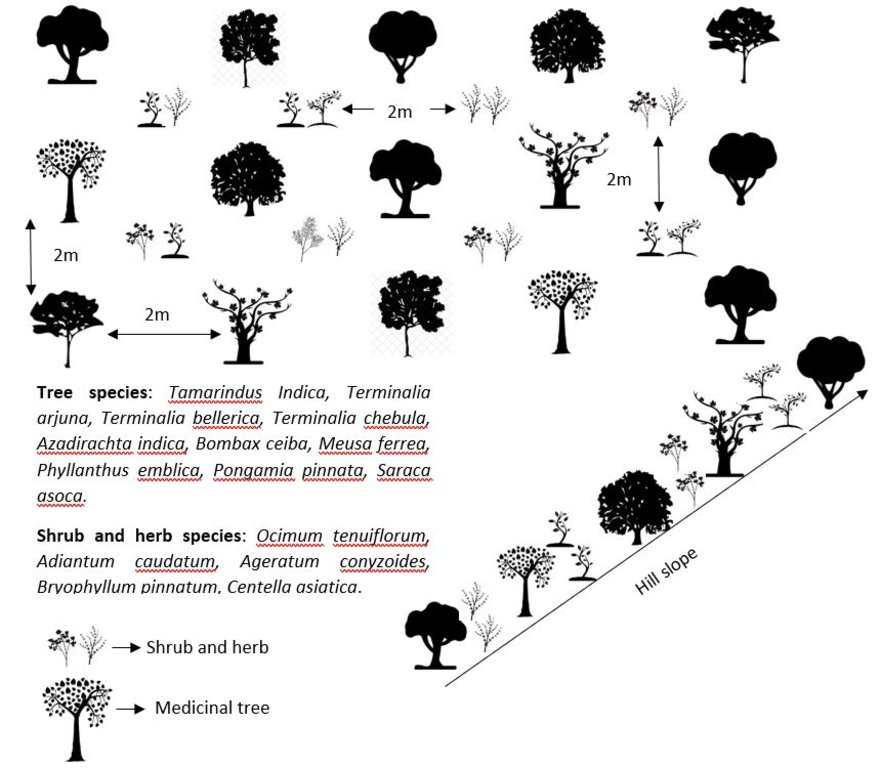Protection from land degradation through conservation of medicinal plants by involving ethnic communities. [บังกลาเทศ]
- ผู้สร้างสรรค์:
- การอัพเดท:
- ผู้รวบรวม: Fazlay Arafat
- ผู้เรียบเรียง: Mutasim Billah, Md. Arfanuzzaman
- ผู้ตรวจสอบ: Nicole Harari, Rima Mekdaschi Studer, Ursula Gaemperli
Herbal medicine plantation to stop land degradation
technologies_4287 - บังกลาเทศ
ดูส่วนย่อย
ขยายทั้งหมด ย่อทั้งหมด1. ข้อมูลทั่วไป
1.2 รายละเอียดที่ติดต่อได้ของผู้รวบรวมและองค์กรที่เกี่ยวข้องในการประเมินและการจัดเตรียมทำเอกสารของเทคโนโลยี
วิทยากรหลัก
ผู้ใช้ที่ดิน:
Thoai Uba
Bolipara Nari Kalyan Somity (BNKS)
บังกลาเทศ
ผู้ใช้ที่ดิน:
Shing Nue Hla
Bolipara Nari Kalyan Somity (BNKS)
บังกลาเทศ
ชื่อของโครงการซึ่งอำนวยความสะดวกในการทำเอกสารหรือการประเมินเทคโนโลยี (ถ้าเกี่ยวข้อง)
Decision Support for Mainstreaming and Scaling out Sustainable Land Management (GEF-FAO / DS-SLM)ชื่อขององค์กรซึ่งอำนวยความสะดวกในการทำเอกสารหรือการประเมินเทคโนโลยี (ถ้าเกี่ยวข้อง)
FAO Bangladesh (FAO Bangladesh) - บังกลาเทศชื่อขององค์กรซึ่งอำนวยความสะดวกในการทำเอกสารหรือการประเมินเทคโนโลยี (ถ้าเกี่ยวข้อง)
IUCN-The World Conservation Union (IUCN-The World Conservation Union) - บังกลาเทศ1.3 เงื่อนไขการใช้ข้อมูลที่ได้บันทึกผ่านทาง WOCAT
ผู้รวบรวมและวิทยากรหลักยอมรับเงื่อนไขเกี่ยวกับการใช้ข้อมูลที่ถูกบันทึกผ่านทาง WOCAT:
ใช่
1.4 การเปิดเผยเรื่องความยั่งยืนของเทคโนโลยีที่ได้อธิบายไว้
เทคโนโลยีที่ได้อธิบายไว้นี้เป็นปัญหาของความเสื่อมโทรมโทรมของที่ดินหรือไม่ จึงไม่ได้รับการยอมรับว่าเป็นเทคโนโลยีเพื่อการจัดการที่ดินอย่างยั่งยืน:
ไม่ใช่
2. การอธิบายลักษณะของเทคโนโลยี SLM
2.1 การอธิบายแบบสั้น ๆ ของเทคโนโลยี
คำจำกัดความของเทคโนโลยี:
The indigenous community in Bolipara village of the Thanchi upazlia (sub-district) of the Bandarban district are reducing or preventing land degradation through the cultivation and conservation of medicinal plants. This practice provides the raw material needed, by local traditional healers, to produce herbal medicines for the indigenous and tribal peoples.
2.2 การอธิบายแบบละเอียดของเทคโนโลยี
คำอธิบาย:
The Chittagong Hill Tracts (CHT) are well-renowned for its unique physiography that harbors rich biodiversity, and for its distinct and rich culture, traditional, and customary practices because of the predominance of many indigenous communities. It is also one of the few remaining areas in Bangladesh where traditional environmental knowledge (TEK) plays an important part in the daily life and customary practices of indigenous communities. Medicinal plants, of course, are a key component of the local health care system. However, the production and use of traditional medicines (mostly herbal in nature) substantively declined as medicinal plants have become rarer – this is due to rapid changes in land use patterns driven by population growth and economic trends. The risk that interest in and local knowledge of medicinal plant use will reduce or even disappear over time as has occurred in other parts of the world, changing the very nature of indigenous life. Land degradation is another major ecological concern for this area. Shifting cultivation with curtailed fallow periods, deforestation, and unplanned cultivation along the hill slopes has caused land degradation in Bolipara union. It is located in Thanchi upazila (longitude 21º78´, latitude 92º42´) under Bandarban hill district of Bangladesh. The total population of the union is more than 10,000. The ethnic communities living in the area include Bowm, Chakma, Khumi, Marma, Mru, Tripura and Chack. Most of the family depends on agriculture and horticulture for their livelihood. BNKS (Bolipara Nari Kalyan Somity) is an NGO who work here to promote the socio-economic and cultural status of the marginalized and socially excluded peoples. ‘Bolipara Kobiraj Kalyan Somiti’ is another local institution of traditional herbal healers.
In 2008, International Union for Conservation of Nature (IUCN) took the initiative to reduce and prevent land degradation in Bolipara through the cultivation and conservation of medicinal plants by indigenous communities. While forest conversion reduces the diversity and availability of medicinal plants, reforestation with medicinal plants can promote and accelerate forest succession on a previously deforested site. As a part of the IUCN project, medicinal tree species like Tamarindus indica, Terminalia arjuna, Terminalia bellerica, Terminalia chebula, Azadirachta indica, Bombax ceiba, Meusa ferrea, Phyllanthus emblica, Pongamia pinnata, and Saraca asoca were planted on the degraded slopes with a 2m x 2m spacing. In between the tree lines, shrub and herb species like Ocimum tenuiflorum, Adiantum caudatum, Ageratum conyzoides, Bryophyllum pinnatum, and Centella asiatica were planted with same spacing in a crisscross manner. The establishment of medicinal plants requires various inputs and extension services from medicinal plant nurseries to demonstration sites and the engagement of communities and community groups (please see more details under the download link: https://portals.iucn.org/library/node/9589).
In this instance, the planting and conservation of medicinal plants was conducted under the supervision of Buddhist monks (from local temples) and ‘Bolipara Kobiraj Kalyan Somiti’(BNKS). The local community were involved with Nursery preparation (seed collection, bed preparation, poly-bag preparation, manuring, irrigation, etc.), preparation of plantation site (jungle cutting, debris collection, preparation of inspection paths, etc.), plantation activities (pit preparation, tying up of plants with sticks for support, application of fertilizers, compost and biocide, etc.) and maintenance activities (vacancy filing, weeding, fertilizer application, etc.). After the medicinal plantation was established in 2008, the degraded land started to regain its health since trees and plants positively influenced the understory microclimate, the structural complexity of vegetation, and the development of humus layer. The indigenous medicinal plants and trees, because of their deep roots, also reduced topsoil erosion, and prevented gully erosion formation. Currently, the site is observed to have good canopy cover, and functions as a good habitat for a number of bird species and monkeys. The local herbal healers have the access to the plantation site and are able to obtain the raw materials needed to produce their medicines in short periods of time and with less effort. The local community people can collect dry leaves and dead branches from the plantation for firewood. This technology is simple enough to implement by the local people without any need of external financial and technical support. The local herbal healers have to collect raw materials to prepare their medicines.
Medicinal plants are an important component of Bangladesh’s national wealth. Even as they serve as important therapeutic agents in various traditional and modern medicines, our understanding of their abundance, distribution, and novel pharmaceutical compounds is poor. The planting/cultivation and conservation of medicinal plants and adequate engagement of local indigenous communities of Bolipara village is a good example of an action that can promote sustainability in all its dimensions (reduced land degradation, social and economic well-being through increase in raw material availability for traditional healers, etc.). Lack of marketing channel of medicinal raw materials and lack of scientific knowledge and tools for medicinal raw materials handling is a potential threat for sustaining the technology in the long run. The capacities of the local herbal healers can be strengthened through training and the marketing channel can be improved through engaging private sector in traditional medicine value chain.
2.3 รูปภาพของเทคโนโลยี
2.5 ประเทศภูมิภาค หรือสถานที่ตั้งที่เทคโนโลยีได้นำไปใช้และได้รับการครอบคลุมโดยการประเมินนี้
ประเทศ:
บังกลาเทศ
ภูมิภาค/รัฐ/จังหวัด:
Bandarban
ข้อมูลจำเพาะเพิ่มเติมของสถานที่ตั้ง :
Bolipara village, Thanchi
ระบุการกระจายตัวของเทคโนโลยี:
- กระจายไปอย่างสม่ำเสมอในพื้นที่
If precise area is not known, indicate approximate area covered:
- < 0.1 ตร.กม.(10 เฮกตาร์)
Is/are the technology site(s) located in a permanently protected area?
ไม่ใช่
Map
×2.6 วันที่การดำเนินการ
ระบุปีที่ใช้:
2008
2.7 คำแนะนำของเทคโนโลยี
ให้ระบุว่าเทคโนโลยีถูกแนะนำเข้ามาอย่างไร:
- ทางโครงการหรือจากภายนอก
ความคิดเห็น (ประเภทของโครงการ เป็นต้น) :
"Conservation Through Practices" project implemented by IUCN Bangladesh and BNKS. The main objective of the project was to conserve medicinal plants in degraded land areas by the supervision of Monks in Buddhist temples.
3. การจัดประเภทของเทคโนโลยี SLM
3.1 วัตถุประสงค์หลักของเทคโนโลยี
- ปรับปรุงการผลิตให้ดีขึ้น
- ลด ป้องกัน ฟื้นฟู การเสื่อมโทรมของที่ดิน
- รักษาสภาพหรือปรับปรุงความหลากหลายทางชีวภาพ
- สร้างผลกระทบทางด้านเศรษฐกิจที่เป็นประโยชน์
- สร้างผลกระทบทางด้านสังคมที่เป็นประโยชน์
3.2 ประเภทของการใช้ที่ดินในปัจจุบันที่ได้นำเทคโนโลยีไปใช้
Land use mixed within the same land unit:
ไม่ใช่

ป่า/พื้นที่ทำไม้
- ป่า/พื้นที่ทำไม้
Tree plantation, afforestation: Specify origin and composition of species:
- การปลูกหลายพันธุ์รวมกัน
Type of tree plantation, afforestation:
- subtropical humid forest plantation - broadleaf
- Tamarindus Indica, Terminalia arjuna, Terminalia bellerica, Terminalia chebula, Azadirachta indica, Bombax ceiba, Meusa ferrea, Phyllanthus emblica, Pongamia pinnata, Saraca asoca, Ocimum tenuiflorum, Adiantum caudatum, Ageratum conyzoides, Bryophyllum pinnatum, Centella asiatica.
Are the trees specified above deciduous or evergreen?
- evergreen
ผลิตภัณฑ์และบริการ:
- ไม้ซุง
- ไม้ที่นำมาทำเป็นเชื้อเพลิง
- ผลไม้และถั่ว
- ผลิตภัณฑ์อื่น ๆ จากป่า
- การอนุรักษ์ / ป้องกันธรรมชาติ
- นันทนาการ / การท่องเที่ยว
- Herbal Medicine
3.3 Has land use changed due to the implementation of the Technology?
Has land use changed due to the implementation of the Technology?
- Yes (Please fill out the questions below with regard to the land use before implementation of the Technology)
Land use mixed within the same land unit:
ไม่ใช่

ที่ดินที่ไม่ให้ผลผลิต
ระบุ:
The hill slope remains barren other than covered by some natural herbs and shrubs.
ข้อสังเกต:
Soil erosion and land slide was a common phenomena in that area.
3.4 การใช้น้ำ
การใช้น้ำของที่ดินที่มีการใช้เทคโนโลยีอยู่:
- น้ำฝนร่วมกับการชลประทาน
3.5 กลุ่ม SLM ที่ตรงกับเทคโนโลยีนี้
- การจัดการสวนป่า
- การปรับปรุงดิน / พืชคลุมดิน
- การปรับปรุงพันธุ์พืชหรือพันธุ์สัตว์ต่าง ๆ
3.6 มาตรการ SLM ที่ประกอบกันเป็นเทคโนโลยี

มาตรการอนุรักษ์ด้วยวิธีพืช
- V1: ต้นไม้และพุ่มไม้คลุมดิน
3.7 รูปแบบหลักของการเสื่อมโทรมของที่ดินที่ได้รับการแก้ไขโดยเทคโนโลยี

การกัดกร่อนของดินโดยน้ำ
- Wt (Loss of topsoil): การสูญเสียดินชั้นบนหรือการกัดกร่อนที่ผิวดิน
- Wm (Mass movement): การเคลื่อนตัวของมวลดินหรือดินถล่ม

การเสื่อมโทรมของดินทางด้านชีวภาพ
- Bc (Reduction of vegetation cover): การลดลงของจำนวนพืชที่ปกคลุมดิน
- Bs (Quality and species composition): องค์ประกอบหรือความหลากหลายทางคุณภาพและชนิดพันธุ์ลดลง
3.8 การป้องกัน การลดลง หรือการฟื้นฟูความเสื่อมโทรมของที่ดิน
ระบุเป้าหมายของเทคโนโลยีกับความเสื่อมโทรมของที่ดิน:
- ลดความเสื่อมโทรมของดิน
4. ข้อมูลจำเพาะด้านเทคนิค กิจกรรมการนำไปปฏิบัติใช้ ปัจจัยนำเข้า และค่าใช้จ่าย
4.1 แบบแปลนทางเทคนิคของเทคโนโลยี
ข้อมูลจำเพาะด้านเทคนิค (แบบแปลนทางเทคนิคของเทคโนโลยี):
Dimension of plantation: across the slope;
Spacing between Tree species: 2m X 2m;
Spacing between Shrub and herb species: 2m X 2m;
shrub and herb species planted in between tree lines with crisscross manner
ผู้เขียน:
Md. Fazlay Arafat
วันที่:
21/04/2019
4.2 ข้อมูลทั่วไปเกี่ยวกับการคำนวณปัจจัยนำเข้าและค่าใช้จ่าย
ให้ระบุว่าค่าใช้จ่ายและปัจจัยนำเข้าได้รับการคำนวณอย่างไร:
- ต่อพื้นที่ที่ใช้เทคโนโลยี
ระบุขนาดและหน่วยพื้นที่:
1 hectare
If using a local area unit, indicate conversion factor to one hectare (e.g. 1 ha = 2.47 acres): 1 ha =:
2.47 acres
อื่นๆ หรือสกุลเงินประจำชาติ (ระบุ):
BDT
If relevant, indicate exchange rate from USD to local currency (e.g. 1 USD = 79.9 Brazilian Real): 1 USD =:
83.0
ระบุค่าเฉลี่ยของค่าจ้างในการจ้างแรงงานต่อวัน:
BDT 500
4.3 กิจกรรมเพื่อการจัดตั้ง
| กิจกรรม | Timing (season) | |
|---|---|---|
| 1. | Nursery preparation (seed collection, site clearing, leveling and fencing, drainage arrangement, bed preparation, making overhead shed, poly-bag preparation, potting seeds, manuring, irrigation, weed control) | September-October |
| 2. | Site preparation (boundary demarcation, jungle cutting, debris collection and staging, preparation of inspection paths and fire lines) | May-June |
| 3. | Plantation (pit preparation, tying up of plants, application of fertilizers, compost and biocide, stick for support) | June-July |
4.4 ค่าใช้จ่ายของปัจจัยนำเข้าที่จำเป็นสำหรับการจัดตั้ง
| ปัจจัยนำเข้า | หน่วย | ปริมาณ | ค่าใช้จ่ายต่อหน่วย | ค่าใช้จ่ายทั้งหมดต่อปัจจัยนำเข้า | %ของค่าใช้จ่ายที่ก่อให้เกิดขึ้นโดยผู้ใช้ที่ดิน | |
|---|---|---|---|---|---|---|
| แรงงาน | Nursery preparation (seed collection, site clearing, leveling and fencing, drainage arrangement, bed preparation, making overhead shed, poly-bag preparation, potting seeds, manuring, irrigation, weed control) | person-days | 25.0 | 500.0 | 12500.0 | 100.0 |
| แรงงาน | Plantation site preparation (boundary demarcation, jungle cutting, debris collection and staging, preparation of inspection paths and fire lines) | person-days | 13.0 | 500.0 | 6500.0 | 100.0 |
| แรงงาน | Plantation (pit preparation, tying up of plants, application of fertilizers, compost and biocide, stick for support) | person-days | 27.0 | 500.0 | 13500.0 | 100.0 |
| อุปกรณ์ | Poly-bags | pieces | 3000.0 | 1.0 | 3000.0 | |
| อุปกรณ์ | Bamboo for shed and bed edging | pieces | 6.0 | 250.0 | 1500.0 | |
| อุปกรณ์ | Nursery equipment (Bucket, spade, scissor, knife etc.) | Lump sum | 1.0 | 600.0 | 600.0 | |
| วัสดุด้านพืช | Procure and transport of loamy soil for filling 3000 poly-bags (17.78cmX1270cm ) | Cubic Meter | 3.0 | 400.0 | 1200.0 | |
| วัสดุด้านพืช | Seed purchase | Kg | 3.0 | 500.0 | 1500.0 | |
| วัสดุด้านพืช | Bamboo stick for tying up of plants | pieces | 2600.0 | 2.0 | 5200.0 | |
| ปุ๋ยและสารฆ่า/ยับยั้งการเจริญเติบโตของสิ่งมีชีวิต (ไบโอไซด์) | Compost | Kg | 700.0 | 4.0 | 2800.0 | |
| ปุ๋ยและสารฆ่า/ยับยั้งการเจริญเติบโตของสิ่งมีชีวิต (ไบโอไซด์) | Urea | Kg | 15.0 | 35.0 | 525.0 | |
| ปุ๋ยและสารฆ่า/ยับยั้งการเจริญเติบโตของสิ่งมีชีวิต (ไบโอไซด์) | TSP | Kg | 15.0 | 40.0 | 600.0 | |
| ปุ๋ยและสารฆ่า/ยับยั้งการเจริญเติบโตของสิ่งมีชีวิต (ไบโอไซด์) | MOP | Kg | 15.0 | 30.0 | 450.0 | |
| ปุ๋ยและสารฆ่า/ยับยั้งการเจริญเติบโตของสิ่งมีชีวิต (ไบโอไซด์) | Biocide | Lump Sum | 1.0 | 200.0 | 200.0 | |
| วัสดุสำหรับก่อสร้าง | Signboard (for demarcation of plantation site) | Lump Sum | 1.0 | 1000.0 | 1000.0 | 100.0 |
| ค่าใช้จ่ายทั้งหมดของการจัดตั้งเทคโนโลยี | 51075.0 | |||||
| Total costs for establishment of the Technology in USD | 615.36 | |||||
แสดงความคิดเห็น:
Traditional local healers and Buddhist monks of Bolipara are the land user here. The project of IUCN Bangladesh titled as, ‘One Stop Service: facilitating conservation of medicinal plant and traditional health service to ethnic communities of Chittagong Hill Tracts (CHT) Bangladesh’ covered some cost of the technology.
4.5 การบำรุงรักษาสภาพหรือกิจกรรมที่เกิดขึ้นเป็นประจำ
| กิจกรรม | ช่วงระยะเวลา/ความถี่ | |
|---|---|---|
| 1. | Vacancy filing | June-July |
| 2. | Tying up of plants | June-July |
| 3. | Fertilizer application | June-July |
| 4. | Weeding | Three times in a year |
4.6 ค่าใช้จ่ายของปัจจัยนำเข้าและกิจกรรมที่เกิดขึ้นเป็นประจำที่ต้องการการบำรุงรักษา (ต่อปี)
| ปัจจัยนำเข้า | หน่วย | ปริมาณ | ค่าใช้จ่ายต่อหน่วย | ค่าใช้จ่ายทั้งหมดต่อปัจจัยนำเข้า | %ของค่าใช้จ่ายที่ก่อให้เกิดขึ้นโดยผู้ใช้ที่ดิน | |
|---|---|---|---|---|---|---|
| แรงงาน | Vacancy filling | Person-days | 6.0 | 500.0 | 3000.0 | 100.0 |
| แรงงาน | Tying up of plants | Person-days | 1.0 | 500.0 | 500.0 | 100.0 |
| แรงงาน | Fertilizer application | Person-days | 5.0 | 500.0 | 2500.0 | 100.0 |
| แรงงาน | Weeding (3 times) | Person-days | 18.0 | 500.0 | 9000.0 | 100.0 |
| วัสดุด้านพืช | Bamboo stick for tying up of plants | pieces | 550.0 | 2.0 | 1100.0 | |
| วัสดุด้านพืช | Seedling | pieces | 500.0 | 5.0 | 2500.0 | 100.0 |
| ปุ๋ยและสารฆ่า/ยับยั้งการเจริญเติบโตของสิ่งมีชีวิต (ไบโอไซด์) | NPK fertilizer | Kg | 125.0 | 30.0 | 3750.0 | |
| ค่าใช้จ่ายทั้งหมดของการบำรุงรักษาสภาพเทคโนโลยี | 22350.0 | |||||
| Total costs for maintenance of the Technology in USD | 269.28 | |||||
ถ้าผู้ใช้ที่ดินรับภาระน้อยกว่า 100% ของค่าใช้จ่าย ให้ระบุว่าใครเป็นผู้รับผิดชอบส่วนที่เหลือ:
The project "One Stop Service: facilitating conservation of medicinal plant and traditional health service to ethnic communities of Chittagong Hill Tracts (CHT) Bangladesh" covered some maintenance cost of the plantation.
4.7 ปัจจัยสำคัญที่สุดที่มีผลกระทบต่อค่าใช้จ่าย
ปัจจัยสำคัญที่สุดที่มีผลกระทบต่อค่าใช้จ่ายต่างๆ:
Labor cost
5. สิ่งแวดล้อมทางธรรมชาติและของมนุษย์
5.1 ภูมิอากาศ
ฝนประจำปี
- < 250 ม.ม.
- 251-500 ม.ม.
- 501-750 ม.ม.
- 751-1,000 ม.ม.
- 1,001-1,500 ม.ม.
- 1,501-2,000 ม.ม.
- 2,001-3,000 ม.ม.
- 3,001-4,000 ม.ม.
- > 4,000 ม.ม.
ระบุปริมาณน้ำฝนเฉลี่ยรายปี (ถ้ารู้) :หน่วย ม.ม.
2528.00
เขตภูมิอากาศเกษตร
- กึ่งชุ่มชื้น
Mean annual temperature is 25.9 °C
5.2 สภาพภูมิประเทศ
ค่าเฉลี่ยความลาดชัน:
- ราบเรียบ (0-2%)
- ลาดที่ไม่ชัน (3-5%)
- ปานกลาง (6-10%)
- เป็นลูกคลื่น (11-15%)
- เป็นเนิน (16-30%)
- ชัน (31-60%)
- ชันมาก (>60%)
ธรณีสัณฐาน:
- ที่ราบสูง/ที่ราบ
- สันเขา
- ไหล่เขา
- ไหล่เนินเขา
- ตีนเนิน
- หุบเขา
ระดับความสูง:
- 0-100 เมตร
- 101-500 เมตร
- 501-1,000 เมตร
- 1,001-1,500 เมตร
- 1,501-2,000 เมตร
- 2,001-2,500 เมตร
- 2,501-3,000 เมตร
- 3,001-4,000 เมตร
- > 4,000 เมตร
ให้ระบุถ้าเทคโนโลยีได้ถูกนำไปใช้:
- บริเวณสันเขา (convex situations)
5.3 ดิน
ค่าเฉลี่ยความลึกของดิน:
- ตื้นมาก (0-20 ซ.ม.)
- ตื้น (21-50 ซ.ม.)
- ลึกปานกลาง (51-80 ซ.ม.)
- ลึก (81-120 ซ.ม.)
- ลึกมาก (>120 ซ.ม.)
เนื้อดิน (ดินชั้นบน):
- ปานกลาง (ดินร่วน ทรายแป้ง)
เนื้อดินล่าง (> 20 ซ.ม.ต่ำจากผิวดิน):
- ปานกลาง (ดินร่วน ทรายแป้ง)
อินทรียวัตถุในดิน:
- ปานกลาง (1-3%)
5.4 ความเป็นประโยชน์และคุณภาพของน้ำ
ระดับน้ำใต้ดิน:
> 50 เมตร
น้ำไหลบ่าที่ผิวดิน:
ปานกลาง
คุณภาพน้ำ (ที่ยังไม่ได้บำบัด):
เป็นน้ำเพื่อการดื่มที่ไม่ดี (จำเป็นต้องได้รับการบำบัด)
Water quality refers to:
surface water
ความเค็มของน้ำเป็นปัญหาหรือไม่:
ไม่ใช่
กำลังเกิดน้ำท่วมในพื้นที่หรือไม่:
ไม่ใช่
5.5 ความหลากหลายทางชีวภาพ
ความหลากหลายทางชนิดพันธุ์:
- สูง
ความหลากหลายของแหล่งที่อยู่:
- ปานกลาง
5.6 ลักษณะของผู้ใช้ที่ดินที่นำเทคโนโลยีไปปฏิบัติใช้
อยู่กับที่หรือเร่ร่อน:
- อยู่กับที่
แนวทางการตลาดของระบบการผลิต:
- เพื่อการยังชีพ (หาเลี้ยงตนเอง)
รายได้ที่มาจากนอกฟาร์ม:
- < 10% ของรายได้ทั้งหมด
ระดับของความมั่งคั่งโดยเปรียบเทียบ:
- ยากจนมาก
เป็นรายบุคคล/ครัวเรือน:
- กลุ่ม/ชุมชน
ระดับของการใช้เครื่องจักรกล:
- งานที่ใช้แรงกาย
เพศ:
- หญิง
- ชาย
อายุของผู้ใช้ที่ดิน:
- ผู้เยาว์
- วัยกลางคน
- ผู้สูงอายุ
5.7 Average area of land used by land users applying the Technology
- < 0.5 เฮกตาร์
- 0.5-1 เฮกตาร์
- 1-2 เฮกตาร์
- 2-5 เฮกตาร์
- 5-15 เฮกตาร์
- 15-50 เฮกตาร์
- 50-100 เฮกตาร์
- 100-500 เฮกตาร์
- 500-1,000 เฮกตาร์
- 1,000-10,000 เฮกตาร์
- >10,000 เฮกตาร์
พิจารณาว่าเป็นขนาดเล็ก กลาง หรือขนาดใหญ่ (ซึ่งอ้างอิงถึงบริบทระดับท้องถิ่น):
- ขนาดเล็ก
5.8 กรรมสิทธิ์ในที่ดิน สิทธิในการใช้ที่ดินและสิทธิในการใช้น้ำ
กรรมสิทธิ์ในที่ดิน:
- เป็นแบบชุมชนหรือหมู่บ้าน
สิทธิในการใช้ที่ดิน:
- เกี่ยวกับชุมชน (ถูกจัดระเบียบ)
สิทธิในการใช้น้ำ:
- เข้าถึงได้แบบเปิด (ไม่ได้จัดระเบียบ)
Are land use rights based on a traditional legal system?
ไม่ใช่
ระบุ:
The private land was donated to the Bolipara Kobiraj Kalyan Somiti by its original owner. The Bolipara Kobiraj Kalyan Somiti is a local institution of traditional healers and Buddhist monk.
5.9 การเข้าถึงบริการและโครงสร้างพื้นฐาน
สุขภาพ:
- จน
- ปานกลาง
- ดี
การศึกษา:
- จน
- ปานกลาง
- ดี
ความช่วยเหลือทางด้านเทคนิค:
- จน
- ปานกลาง
- ดี
การจ้างงาน (เช่น ภายนอกฟาร์ม):
- จน
- ปานกลาง
- ดี
ตลาด:
- จน
- ปานกลาง
- ดี
พลังงาน:
- จน
- ปานกลาง
- ดี
ถนนและการขนส่ง:
- จน
- ปานกลาง
- ดี
น้ำดื่มและการสุขาภิบาล:
- จน
- ปานกลาง
- ดี
บริการด้านการเงิน:
- จน
- ปานกลาง
- ดี
6. ผลกระทบและสรุปคำบอกกล่าว
6.1 ผลกระทบในพื้นที่ดำเนินการ (On-site) จากการใช้เทคโนโลยี
ผลกระทบทางด้านเศรษฐกิจและสังคม
การผลิต
คุณภาพป่า /พื้นที่ทำไม้
การผลิตของจากป่าทุกชนิดยกเว้นไม้
การเสี่ยงต่อความล้มเหลวในการผลิต
ความหลากหลายของผลิตภัณฑ์
พื้นที่สำหรับการผลิต
รายได้และค่าใช้จ่าย
รายได้จากฟาร์ม
แสดงความคิดเห็น/ระบุ:
local traditional healers and their family profit from the medical plants
ความหลากหลายของแหล่งผลิตรายได้
ผลกระทบด้านสังคมวัฒนธรรมอื่น ๆ
สถานการณ์ด้านสุขภาพ
โอกาสทางวัฒนธรรม
แสดงความคิดเห็น/ระบุ:
Local healers now able to extract various medicinal plants and display herbal medicines in local herbal fair
สถาบันของชุมชน
แสดงความคิดเห็น/ระบุ:
The community institution "Bolipara Kobiraj Kalyan Somiti" has been strengthened through their improved cooperation and availability of raw materials for medicines.
SLM หรือความรู้เรื่องความเสื่อมโทรมของที่ดิน
แสดงความคิดเห็น/ระบุ:
The local community learned how to improve a degraded site with tree plantation.
สถานการณ์ของกลุ่มด้อยโอกาส ทางด้านสังคมและเศรษฐกิจ
แสดงความคิดเห็น/ระบุ:
The situation of local traditional healers improved as they now manage source of raw materials by themselves for their medicines
ผลกระทบด้านนิเวศวิทยา
วัฐจักรน้ำหรือน้ำบ่า
น้ำไหลบ่าที่ผิวดิน
การระบายน้ำส่วนเกิน
น้ำบาดาลหรือระดับน้ำในแอ่งน้ำบาดาล
ดิน
ความชื้นในดิน
สิ่งปกคลุมดิน
การสูญเสียดิน
การหมุนเวียนและการเติมของธาตุอาหาร
อินทรียวัตถุในดิน/ต่ำกว่าดินชั้น C
ความหลากหลายทางชีวภาพของพืชและสัตว์
การปกคลุมด้วยพืช
มวลชีวภาพ/เหนือดินชั้น C
ความหลากหลายทางชีวภาพของพืช
พืชพันธุ์ต่างถิ่นที่รุกล้ำเข้ามา
ความหลากหลายทางชีวภาพของสัตว์
ชนิดพันธุ์ที่ให้ประโยชน์
ความหลากหลายของสัตว์
การจัดการศัตรูพืชและโรคพืช
ลดความเสี่ยงของภัยพิบัติ
ดินถล่ม/ ซากต่าง ๆ ที่ถูกพัดพามา
การปล่อยคาร์บอนและก๊าซเรือนกระจก
ความเสี่ยงจากไฟ
แสดงความคิดเห็น/ระบุ:
The plantation reduces the risk of incendiary fire for shifting cultivation
ความเร็วของลม
ภูมิอากาศจุลภาค
6.2 ผลกระทบนอกพื้นที่ดำเนินการ (Off-site) จากการใช้เทคโนโลยี
การไหลของน้ำคงที่และสม่ำเสมอในช่วงฤดูแล้ง
แสดงความคิดเห็น/ระบุ:
The canopy cover of the plantation site improves the watershed management and increased the stable streams flows in dry season
ผลกระทบของก๊าซเรือนกระจก
6.3 การเผชิญและความตอบสนองของเทคโนโลยีต่อการเปลี่ยนแปลงสภาพภูมิอากาศที่ค่อยเป็นค่อยไป และสภาพรุนแรงของภูมิอากาศ / ภัยพิบัติ (ที่รับรู้ได้โดยผู้ใช้ที่ดิน)
การเปลี่ยนแปลงสภาพภูมิอากาศที่ค่อยเป็นค่อยไป
การเปลี่ยนแปลงสภาพภูมิอากาศที่ค่อยเป็นค่อยไป
| ฤดู | increase or decrease | เทคโนโลยีมีวิธีการรับมืออย่างไร | |
|---|---|---|---|
| อุณหภูมิประจำปี | เพิ่มขึ้น | ไม่ทราบ | |
| อุณหภูมิตามฤดูกาล | ฤดูแล้ง | เพิ่มขึ้น | ปานกลาง |
| ฝนประจำปี | ลดลง | ไม่ทราบ | |
| ฝนตามฤดู | ฤดูฝน | เพิ่มขึ้น | ดี |
สภาพรุนแรงของภูมิอากาศ (ภัยพิบัติ)
ภัยพิบัติจากน้ำ
| เทคโนโลยีมีวิธีการรับมืออย่างไร | |
|---|---|
| ดินถล่ม | ดี |
6.4 การวิเคราะห์ค่าใช้จ่ายและผลประโยชน์ที่ได้รับ
ผลประโยชน์ที่ได้รับเปรียบเทียบกับค่าใช้จ่ายในการจัดตั้งเป็นอย่างไร (จากมุมมองของผู้ใช้ที่ดิน)
ผลตอบแทนระยะสั้น:
ด้านลบเล็กน้อย
ผลตอบแทนระยะยาว:
ด้านบวกอย่างมาก
ผลประโยชน์ที่ได้รับเปรียบเทียบกับค่าใช้จ่ายในการบำรุงรักษาหรือต้นทุนที่เกิดขึ้นซ้ำอีก เป็นอย่างไร (จากมุมมองของผู้ใช้ที่ดิน)
ผลตอบแทนระยะสั้น:
ด้านลบเล็กน้อย
ผลตอบแทนระยะยาว:
ด้านบวกอย่างมาก
6.5 การปรับตัวของเทคโนโลยี
- 1-10%
Of all those who have adopted the Technology, how many did so spontaneously, i.e. without receiving any material incentives/ payments?
- 0-10%
6.6 การปรับตัว
เทคโนโลยีได้รับการปรับเปลี่ยนเมื่อเร็วๆนี้ เพื่อให้ปรับตัวเข้ากับสภาพที่กำลังเปลี่ยนแปลงหรือไม่:
ไม่ใช่
6.7 จุดแข็ง / ข้อได้เปรียบ / โอกาสของเทคโนโลยี
| จุดแข็ง / ข้อได้เปรียบ / โอกาสในทัศนคติของผู้ใช้ที่ดิน |
|---|
| Reduction in land degradation. |
| Enhancement of the supply of medicinal raw materials. |
| Conservation of rare and endangered medicinal plant species. |
| จุดแข็ง / ข้อได้เปรียบ / โอกาสในทัศนคติของผู้รวบรวมหรือวิทยากรหลัก |
|---|
| Builds community awareness of biodiversity conservation |
| Increase of carbon sequestration |
6.8 จุดอ่อน / ข้อเสียเปรียบ / ความเสี่ยงของเทคโนโลยีและวิธีการแก้ไข
| จุดอ่อน / ข้อเสียเปรียบ / ความเสี่ยงในทัศนคติของผู้ใช้ที่ดิน | มีวิธีการแก้ไขได้อย่างไร |
|---|---|
| Land use conflicts for short term income. The tree species require significant time to grow and yield fruits and flowers for herbal use. Short term return from the plantation site is low compared to other land uses e.g. shifting cultivation, annual crop cultivation, etc. | There is a need to diversify income sources for the communities |
| Adjacent commercial teak plantation is a threat to soil erosion. | Requires engagement of the teak plantation owners and increasing knowledge of local community |
| Lack of capacities for medicinal raw materials storage. | Could potentially involve private organizations in the medicinal value chain |
| จุดอ่อน / ข้อเสียเปรียบ / ความเสี่ยงในทัศนคติของผู้รวบรวมหรือวิทยากรหลัก | มีวิธีการแก้ไขได้อย่างไร |
|---|---|
| Lack of training and tools for proper use of medicinal raw materials. | Strengthen the capacities of local healers through training |
| Lack of marketing channel to distribute herbal medicines in other places. | Opportunity to involve the private sector in traditional medicine value chain |
7. การอ้างอิงและการเชื่อมต่อ
7.1 วิธีการและแหล่งข้อมูล
- ไปเยี่ยมชมภาคสนาม การสำรวจพื้นที่ภาคสนาม
Number of informants: 04
- การสัมภาษณ์กับผู้ใช้ที่ดิน
Number of informants: 03
- การเก็บรวบรวมมาจากรายงานและเอกสารที่มีอยู่
Number of informants: 02
วันที่เก็บรวบรวมข้อมูล(ภาคสนาม) :
17/12/2018
7.2 การอ้างอิงถึงสิ่งตีพิมพ์
หัวข้อ, ผู้เขียน, ปี, หมายเลข ISBN:
Motaleb, M.A. et al. 2011. Selected Medicinal Plants of Chittagong Hill Tracts. ISBN: 978-984-33-3650-7
ชื่อเรื่อง ผู้เขียน ปี ISBN:
IUCN Bangladesh
หัวข้อ, ผู้เขียน, ปี, หมายเลข ISBN:
Motaleb, M. A., 2010. Approaches to Conservation of Medicinal Plants and Traditional Knowledge: A Focus on the Chittagong Hill Tracts. IUCN (International Union for Conservation of Nature), Bangladesh Country Office, Dhaka, Bangladesh, pp viii+30.
ชื่อเรื่อง ผู้เขียน ปี ISBN:
https://portals.iucn.org/library/sites/library/files/documents/2010-030.pdf
7.3 Links to relevant online information
ชื่อเรื่องหรือคำอธิบาย:
Medicinal Plant Abundance in Degraded and Reforested Sites in Northwest Pakistan
URL:
URL: https://doi.org/10.1659/MRD-JOURNAL-D-09-00017.1
7.4 General comments
The WOCAT questionnaire covers all the technical aspects of this technology
ลิงก์และโมดูล
ขยายทั้งหมด ย่อทั้งหมดลิงก์
ไม่มีลิงก์
โมดูล
ไม่มีโมดูล


